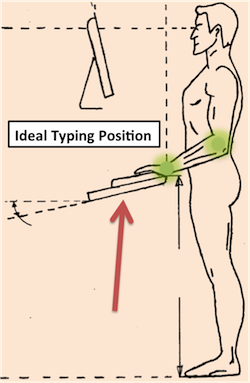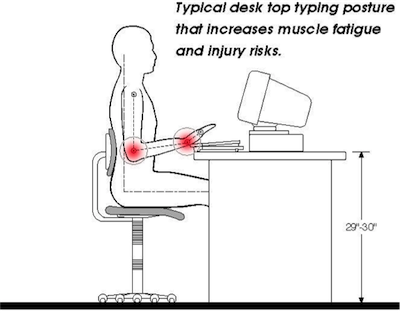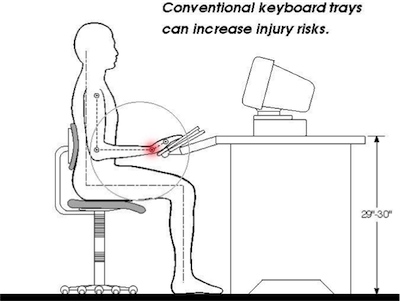 Carpal Tunnel syndrome is incredibly painful, and it only gets more likely the longer you sit at a keyboard. You probably know something about Carpal Tunnel – but did you know that sitting increases your risk?
Carpal Tunnel syndrome is incredibly painful, and it only gets more likely the longer you sit at a keyboard. You probably know something about Carpal Tunnel – but did you know that sitting increases your risk?
I’ve never seen anyone else talk about it, but a huge benefit of standing is that it gets those darn legs out of the way. And clearing out those pesky lower limbs can protect you from Carpal Tunnel and improve shoulder health.
The secret? Dropping your keyboard and tilting it back – something that’s pretty much impossible with your knees right up under your desk.
The Seated Typist Problem
When you sit down, you want your legs to fit under your desk. That way, you can saddle right on up to your keyboard without knocking your knees or spreading wide.
Come typing time, you need your keyboard on top of your desk, so you can, you know, actually hit the keys. For people without T-Rex arms, having the keyboard that high above your thighs means your elbows will be bent tight, and your wrists will have to bend away from you to type. Like this:

Look familiar? This is how most desk work is done. [img credit]
The weight of those outstretched limbs causes many people to rest their hands on the desk, resulting in pressure points and nasty local myofascial issues. So people buy those gel-padded wrist rests, decreasing the pressure points, but tightening the elbow angle and throwing your wrist over a big bump. Someone noticed this whole mess, and gave fixing it a shot…
Seated Keyboard Trays: It hurts worse!

Irony (noun): an ergonomic device that increases pain and injury. [img credit]
“Try Tilting it the Other Way”
So far, we’ve seen that flat keyboards don’t work, and tilting them forward makes the problem worse. What does the research say when we tilt the keyboard back?
- “Angles ranging from 0 degrees to -30 degrees… provide significant reductions in exposure to deviated wrist postures and muscle activity and comparable performance.”[1]
- “The downward sloping of computer keyboards… could possibly be beneficial in the prevention of musculoskeletal disorders affecting the wrist.”[2]
- “A negative slope design has a geometrical advantage over other keyboards.”[3]
Bingo! We’ve found our solution. Except there’s a catch. You have to greatly open your elbow angle to maintain neutral wrist positioning with a negative-tilt keyboard. When your elbows open up, your wrists go below your waist – impossible to achieve at a sitting desk with those pesky thighs in the way. Fortunately for us, we’re all working at standing desks now anyway!
Standing Desks Fix Wrists, Elbows, Shoulders, and Backs too.
Getting your legs out of the way makes these health issue a thing of the past. Since we’re standing, we can tilt that keyboard back and put it as low as we want, grabbing three benefits:
- Neutral wrist angle means no Carpal Tunnel.
- Open elbows means less fatigue and inflammation (no tendonitis)
- Keeping our hands closer to our bodies takes the load off our shoulders and lower backs, without adding pressure points.
Here’s what you want your desk to look like:
How to Get Your Own Drop Keyboard Setup
- If you build your own desk with the free plans from here, you have a whole dropped shelf for your keyboard and mouse.
- If you already have a standing desk, you can get a drop keyboard tray and swing it all the way down and back.
- We’re currently trying to convince a prominent sit-stand desk manufacturer to provide a “droppable keyboard” option (patent-pending). If you want one, leave a comment to show your support!
However you go about it, dropping and tilting your keyboard will make you healthier and more productive.





















